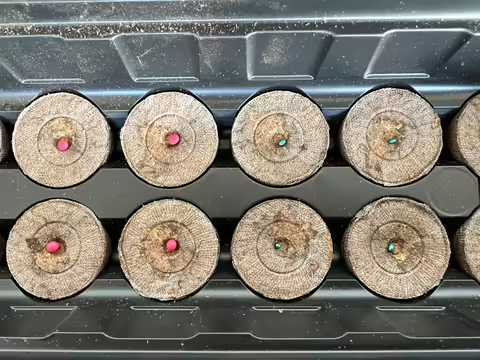URBANA, Ill. – Have you noticed the windowed packets of seeds at garden centers with brightly colored “seeds”? These pelleted seeds are small or irregular seed that have a specialized inert coating applied to improve planting, spacing, and germination. Often the coating, which increases the weight and size of the seed, is colored which aids in planting several varieties of seed in one tray, a row in a garden, or a field.
Mary Fischer, University of Illinois Extension horticulture educator, says while pelleted seed was originally developed for commercial production with a mechanical seeder. Then, seed companies began producing pelleted seed for vegetables and flowers and seeds are now available at local garden centers and big-box stores.
Pelleted seed has been used intermittently since WWI. The improved pelleted seed was introduced for cereal seeds in the 1930s by a British seed company, Germains. In the 1940s, the U.S. used several types of pelleted seed in reforestation studies. The 1960s saw large-scale use of pelletized seed by commercial growers primarily for its ease of use with mechanical planters and new seed coating technologies. In the 1970s, California banned the use of short-handled hoes, increasing the use of pelleted or coated seeds.
Today, pelleted seed has many positive benefits for commercial productions and home gardeners. The coating protects seed from birds, rodents, and a wide range of environmental conditions that often lead to replanting. It reduces loss from needing to thin plants.
“Precise spacing requires less seed, and since the seed is coated and visible, less seed will be used saving gardeners money,” Fischer says.
For large-scale producers, it is easier for specific applications like aerial dropping or mechanical seeders. There are nutrient benefits with increased oxygen availability. The coating allows for pre-inoculation of legume seeds. Since chemicals are applied to the seed and not the whole field, application is safer and there is a lower cost of agricultural chemicals.
One obstacle to widespread adoption of pelleted seed has been the ability of the coating to split open once it is hydrated allowing oxygenated moisture to reach the seed. New levels of coating densities for commercial growers has overcome that issue.
Meghan Shinn has two precautions when using pelleted seed in a March 1, 2020 article from Horticulture Magazine. First, the growing medium needs to remain consistently moist, but not soggy, after the seed is sown. Secondly, all the pelleted seed must be used in the season it is purchased. This should not be a problem with most home gardeners as seed packets contain smaller amounts of seed.
Pelleted seed is very easy to use. The colored coating allows a home gardener to see the seed as it is planted, the seed spacing, and where it is planted before covering with soil. If a home gardener is starting seed in a tray for transplant later, pelleted seed makes it easier to identify the different types of seed as it is planted.
“Another method of planting pelleted seed is to make your own seed tape,” Fischer says. “This is quite easy to do using single-ply toilet paper and glue.”
Simply tear off a length of toilet paper to fit the garden plot. Fold it in half lengthwise and cut into two pieces. Fold each length in half longways and open. Following the recommended spacing on the seed packet, place small dots of glue at the appropriate distance to one side of the fold, then add a seed. Once the entire length has been planted, fold the other side over the seed side.
This tape can be wrapped around an empty paper towel roll and labeled for later use. When ready to plant, prepare the garden bed, lay the tape on the bed, and cover it to the proper depth as directed on the seed packet.
“Don’t take my word for it,” Fischer says. “This spring, plant a pack of pelleted seed next to a pack of non-pelleted seed and compare the results.”
You’ll find an ease of planting, ease of spacing, germination rates, and harvest with pelleted seed.
SOURCE: Mary Fischer, Horticulture Educator, Illinois Extension.
ABOUT EXTENSION: Illinois Extension, the public outreach and engagement arm of the University of Illinois, translates research-based knowledge into actionable insights and strategies that enable Illinois businesses, families, and community leaders to solve problems, adapt to changes and opportunities, make informed decisions, and carry technical advancements forward into practice.
PHOTO ACCESS: The photo in this article is available to download for media use.
